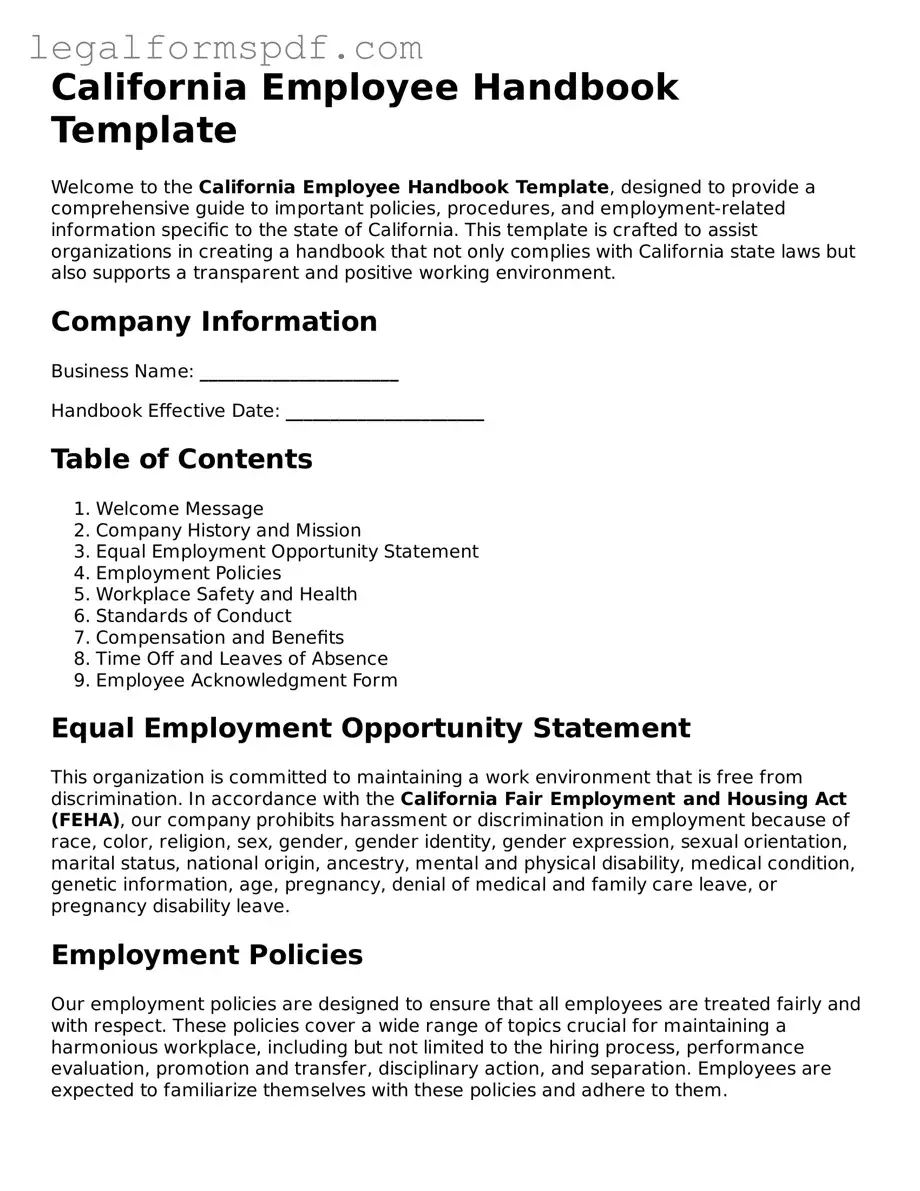California Employee Handbook Template
Welcome to the California Employee Handbook Template, designed to provide a comprehensive guide to important policies, procedures, and employment-related information specific to the state of California. This template is crafted to assist organizations in creating a handbook that not only complies with California state laws but also supports a transparent and positive working environment.
Company Information
Business Name: ______________________
Handbook Effective Date: ______________________
Table of Contents
- Welcome Message
- Company History and Mission
- Equal Employment Opportunity Statement
- Employment Policies
- Workplace Safety and Health
- Standards of Conduct
- Compensation and Benefits
- Time Off and Leaves of Absence
- Employee Acknowledgment Form
Equal Employment Opportunity Statement
This organization is committed to maintaining a work environment that is free from discrimination. In accordance with the California Fair Employment and Housing Act (FEHA), our company prohibits harassment or discrimination in employment because of race, color, religion, sex, gender, gender identity, gender expression, sexual orientation, marital status, national origin, ancestry, mental and physical disability, medical condition, genetic information, age, pregnancy, denial of medical and family care leave, or pregnancy disability leave.
Employment Policies
Our employment policies are designed to ensure that all employees are treated fairly and with respect. These policies cover a wide range of topics crucial for maintaining a harmonious workplace, including but not limited to the hiring process, performance evaluation, promotion and transfer, disciplinary action, and separation. Employees are expected to familiarize themselves with these policies and adhere to them.
Workplace Safety and Health
In adherence to the California Occupational Safety and Health Act (Cal/OSHA), our company is dedicated to providing a safe and healthy work environment for all employees. This section outlines the responsibilities of both employees and management in maintaining workplace safety. It also includes information on how to report safety concerns or incidents.
Standards of Conduct
Maintaining professional conduct is paramount in our workplace. This section defines acceptable and unacceptable behaviors and outlines the consequences of violating these standards. The goal is to ensure a respectful, productive, and safe work environment for everyone.
Compensation and Benefits
Our compensation and benefits package is designed to be competitive and comply with all relevant California laws, including the California Labor Code for wage and hour regulations. This section provides details on salary protocols, bonus schemes, health insurance, retirement benefits, and other perks available to employees.
Time Off and Leaves of Absence
To support our employees' work-life balance, we offer various time off and leave options in compliance with California laws, such as the California Family Rights Act (CFRA) and the Paid Sick Leave law. This section outlines the policies for requesting and taking leave, including eligibility, types of leave available, and the process for returning to work.
Employee Acknowledgment Form
This form is to be signed by the employee to acknowledge that they have received, read, and understood the contents of the handbook. Signing this document also indicates the employee's agreement to adhere to the company's policies and procedures as described in the handbook.
Employee Signature: ______________________
Date: ______________________
